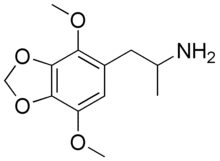DMMDA |
 |
| Legal status |
|---|
| Legal status | |
|---|
| Identifiers |
|---|
IUPAC name 1-(4,7-Dimethoxy-1,3-benzodioxol-5-yl)propan-2-amine
|
| CAS Number | |
|---|
| ChemSpider | |
|---|
| ChEMBL | |
|---|
| CompTox Dashboard (EPA) | |
|---|
| Chemical and physical data |
|---|
| Formula | C12H19NO4 |
|---|
| Molar mass | 241.287 g·mol−1 |
|---|
| 3D model (JSmol) | |
|---|
SMILES CC(N)Cc1cc(OC)c2OCOc2c1OC
|
InChI=1S/C12H17NO4/c1-7(13)4-8-5-9(14-2)11-12(10(8)15-3)17-6-16-11/h5,7H,4,6,13H2,1-3H3  Key:GRGRGLVMGTVCNZ-UHFFFAOYSA-N 
|
| (verify) |
2,5-Dimethoxy-3,4-methylenedioxyamphetamine (DMMDA) is a psychedelic drug of the phenethylamine and amphetamine chemical classes.[1] It was first synthesized by Alexander Shulgin and was described in his book PiHKAL.[1] Shulgin listed the dosage as 30–75 mg and the duration as 6–8 hours.[1] He reported DMMDA as producing LSD-like images, mydriasis, ataxia, and time dilation.[1]
References
This article is copied from an
article on Wikipedia® - the free encyclopedia created and edited by its online user community. The text was not checked or edited by anyone on our staff. Although the vast majority of Wikipedia® encyclopedia articles provide accurate and timely information, please do not assume the accuracy of any particular article. This article is distributed under the terms of
GNU Free Documentation License.
All content on this website, including dictionary, thesaurus, literature, geography, and other reference data is for informational purposes only. This information should not be considered complete, up to date, and is not intended to be used in place of a visit, consultation, or advice of a legal, medical, or any other professional.

